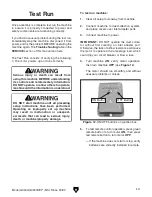
Model G0944/G0944HEP (Mfd. Since 03/21)
-11-
Additional Safety for Dust Collectors
Long-term respiratory damage can occur from using dust collectors without proper use of a
respirator. Fire or explosions can result in smoke inhalation, serious burns, or death—if machine
is used to collect incorrect materials, is operated near potential explosion sources, or ducting is
improperly grounded. Entanglement, amputation, or death can occur if hair, clothing, or fingers
are pulled into the inlet. To reduce the risk of these hazards, operator and bystanders MUST
completely heed the hazards and warnings below.
POWER DISCONNECT. Turn machine OFF, dis-
connect from power supply, and allow impeller
to completely stop before leaving machine unat-
tended, or doing any maintenance or service.
REGULAR CLEANING. To reduce risk of start-
ing a fire, regularly check/empty collection bags
or drum to avoid buildup of fine dust, which can
increase risk of fire. Regularly clean surrounding
area where machine is operated—excessive dust
buildup on overhead lights, heaters, electrical pan-
els, or other heat sources will increase risk of fire.
SUSPENDED DUST PARTICLES. To reduce risk
of death or injury caused by explosions or fires, DO
NOT operate in areas where these risks are high,
including spaces near pilot lights, open flames, or
other ignition sources.
AVOIDING SPARKS. To reduce risk of fire, avoid
collecting any metal objects or stones. These can
possibly produce sparks when they strike impeller,
which can smolder in wood dust for a long time
before a fire is detected. If you accidentally cut
into wood containing metal, immediately turn
OFF
dust collector, disconnect from power, and wait
for impeller to stop. Then empty bag or drum into
approved airtight metal container.
FIRE SUPPRESSION. Only operate dust collector
in locations that contain fire suppression system or
have fire extinguisher nearby.
STATIC ELECTRICITY. To reduce risk of fire or
explosions caused by sparks from static electricity,
ground all ducting using grounding wire.
DUST ALLERGIES. Dust from certain woods will
cause an allergic reaction. Make sure you know
what type of wood dust you will be exposed to in
case of an allergic reaction.
INTENDED USE. Collecting the wrong materi-
als can result in serious inhalation hazards, fire,
explosions, or machine damage. This machine
is ONLY designed to collect wood dust and chips
from woodworking machines. DO NOT use it to
collect silica, polyurethane, toxic fumes, metal dust
or shavings, lead paint, drywall, asbestos, biohaz-
ards, explosive dusts, flammable or combustible
liquids or fumes, nor burning or smoking material.
WEAR A RESPIRATOR. Fine dust that is too
small to be caught in filter will be blown into ambi-
ent air. Always wear a NIOSH-approved respira-
tor during operation and for a short time after to
reduce your risk of permanent respiratory damage.
Never collect dust from any hazardous material.
IMPELLER HAZARDS. To reduce risk of entan-
glement or contact with impeller, DO NOT place
hands, hair, clothing, or tools in or near open dust
collection inlet during operation, and keep small
animals and children away. The powerful suction
could easily pull them into impeller.
HAZARDOUS DUST. Dust exposure created while
using machinery may cause cancer, birth defects,
or long-term respiratory damage. Be aware of dust
hazards associated with each workpiece material,
and always wear a NIOSH-approved respirator.
EMPTYING DUST. When emptying bag or drum,
wear respirator and safety glasses. Empty dust
away from ignition sources and into approved
container.
OPERATING LOCATION. To reduce respiratory
exposure to fine dust, locate permanently installed
dust collectors away from working area or in anoth-
er room. DO NOT place dust collector where it can
be exposed to rain or moisture, which creates a
shock hazard and will reduce life of machine.
Summary of Contents for G0944
Page 36: ......














































